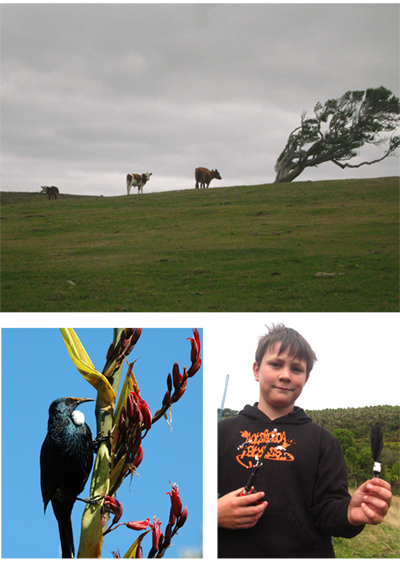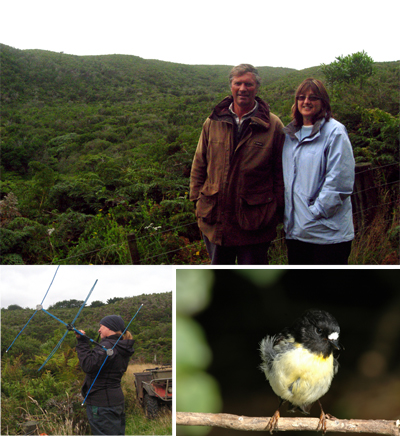Chatham Island Tui Make History
Blowing into the Chatham islands on the kind of Antarctic wind that keeps its trees in a permanent supine position, I’m greeted on the airport’s gangway by a southerly blast that ushers me hurriedly onto a land where the plants, birds and insect life is like no where else in the world.

The Chatham Islands murderous wind; the super-sized Chatham Island tui & the transmittter which tracks each of the birds post-release.
Weta -eating spiders the size of your fist, supersize tui, spike-free lancewood, and over 160 endemic species of insects call this archipelago home, however the majority of these unique species can only be found on the three small, inaccessible offshore islands that surround the mainland.
These very islands hold almost 20% of New Zealand’s threatened bird species (Black Robin, Forbes Parakeet, CI Mollymawk, CI Snipe, CI Shore Plover), but with the hard work of two conservationists these species may stage a return to the main island.
Here to bear witness to the transfer of CI tui onto the main Chatham island after a 25 year absence, I point my jeep in the direction of the Southern tip where the 14 birds are being held pre-release. It only takes a drive through the countryside to see why birds & plants find this land inhospitable.
Large stretches of farmland and patches of bracken fill my window, punctuated by the odd tree set at a 45 degree angle. Farmers removed much of the island’s historical artefacts (Moriori tree carvings) and unique natural heritage* one hundred and fifty years ago by cutting great swathes of forested land, and converting it to farmland.
Now just a few forested patches remain, and the salt-laced, corrosive and sometimes murderous winds, have destroyed exposed parts of these remnants leaving tree cemeteries on their borders.
Rolling up to the tui’s holding aviary in the Awatotara, I was expecting to wowed by their size, but it was their song that struck me. Their staccato three-part harmony ended in a crescendo, that was followed by what is best described as a whooping sneeze.
Chatham Island Tui Transfer 2009 from Mandy Herrick on Vimeo.
‘These birds have the flu. Bird flu!’ joked one of the translocation managers, Mike Bell. In the next few hours the birds were blessed and sung to in all variety of languages – English, Maori and Moriori, before the door was opened onto the lush 70 hectare reserve filled with fruit-bearing trees.
Having snacked on these forest fruits, twelve tui flew in formation above the reserve to the delight of those watching , then ducked into the valley below.
Tui fly great distances in any one day and have known to travel from Invercargill to Stewart Island for a piece of prized bit of tucker, so if all goes to plan they could potentially re-colonise the island, with re-planting and pest control by the locals.
The return of this iconic species was funded by Forest & Bird’s international partner Birdlife international, but the real work started 16 years ago, when Liz and Bruce first began re-planting pockets of their farmland.

Bruce & Liz in front of the tui's new home; Elizabeth bell locates the tui post-release & CI tomtit, one of the species the couple plan to introduce
Two hundred and thirty hectares of their land has now been set aside as a homeland for endemic species struggling to survive, providing ample inspiration for locals wanting to see the return of their native birds.
Already the Tuanui’s share their property with Taiko (nationally critical), CI oyster-catchers (nationally critical), CI wood-pigeon (nationally critical), Pitt island shag (endangered), CI petrel and CI warbler (both nationally vulnerable), however they’re looking to introduce many more – sooty shearwaters & CI tomtit to name a few.
Just before I leap back on my plane I check in on the tui, and all of them are settling in very well, so as I set off to Wellington, I compile a list of the new population on the main Chatham island.
Here’s my very, very rough tally of some of the inhabitants (feathery and otherwise) –
14 CI tui
200 parea (CI wood pigeon)
150 taiko
12,000-10,000 black swans
Untold weka
Untold sheep + cattle
600 – 650 human inhabitants
1 flying hairdresser**
1 police-officer
Let’s hope next time when I return there will be many more endemic feathery inhabitants on the mainland. No doubt, with the vision and muscle of people like Liz and Bruce the Chatham Islands will be dotted with bird-filled forests.
*15 endemic birds have gone extinct in the past 500 years
** The hairdresser flies in every month.
Please feel free to add to this list by posting a comment below!
